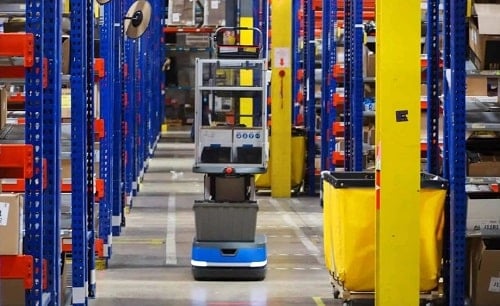
Savvy business owners and logistics providers are adjusting their processes and testing out various fulfillment processes, workflows and strategies (including omnichannel fulfillment) to accommodate and effectively meet the demands of an informed consumer base.
To help you scale, stay ahead of the competition and cope with growing consumer expectations, let’s explore what omnichannel fulfillment is and why it is important.
What is omnichannel fulfillment?
Omnichannel fulfillment is a centralized strategy that enables businesses to streamline and seamlessly execute the order fulfillment process (receive, warehouse, process, pick, package and ship customers’ orders) across multiple channels. This strategy allows logistics providers to remain agile, optimize their fulfillment workflows and efficiently handle/dispatch orders received from multiple selling channels within a single facility.
Essentially, omnichannel fulfillment enables you to automate, simplify and speed up order fulfillment activities to increase customer satisfaction and boost your bottom lines in today’s incredibly competitive marketplace.
A centralized approach to inventory management is a core tenet of omnichannel fulfillment. An integrated inventory tracking system allows businesses to redistribute and reallocate inventory to multiple channels, enabling customers to easily find, order and receive items via their preferred channel. As such, businesses don’t have to set up separate order fulfillment infrastructures for individual sales channels.
The importance of omnichannel order fulfillment
As e-commerce sales volume continues to grow, a lot of online stores now struggle to handle the growing number of customer orders they receive from multiple buying channels. The proliferation of consumerism is also making it difficult for e-commerce stores to enhance the customer experience while keeping bottom lines healthy. This is where an omnichannel fulfillment approach comes in. Let’s take a look at a few of the biggest benefits of leveraging omnichannel fulfillment.
Reduces the cost of exploring alternative sales channels
At its core, omnichannel fulfillment uses an integrated process to optimize logistics and supply chain operations to efficiently fulfill orders across multiple channels. This approach enables brands to reduce shipping time and enhance the customer experience by leveraging a hybrid delivery approach (for example, using physical stores as fulfillment centers). As such, brick-and-mortar retailers can expand into e-commerce without having set up a new network of physical fulfillment centers and warehouses. They can use their already existing physical infrastructure to increase their online reach.
Boosts the customer experience
An omnichannel logistics strategy allows businesses to combine their inventories for online and offline sales channels and integrate the entire process into a unified entity. With this, you can provide customers with unrivaled access to inventory across all channels, real-time tracking options and quick order fulfillment, thus creating a streamlined shopping experience. Improved customer experience leads to higher customer satisfaction, which translates into customer loyalty and increased sales.
Enables flexible fulfillment options
Omnichannel order fulfillment avoids a linear fulfillment process (warehouse – store – end customer) in favor of a more agile and flexible workflow. Omnichannel fulfillment enables businesses to process and deliver orders via a combination of various channels, including:
- Store-to-customer
- Customer-to-store
- Warehouse-to-store
- Warehouse-to-alternative pick-up location
- Customer-to-warehouse
- Warehouse-to-customer
- Store-to-store
Allows businesses to explore new sales channels
A unified fulfillment process and integrated sales channels (both hallmarks of omnichannel fulfillment) make it easier for businesses to remain agile and optimally manage their supply chains for better cost and process efficiencies. Using a real-time warehouse management system and a holistic approach to fulfillment operations enable brands to explore new sales channels with ease.
Frees up time and resources

Order fulfillment is one of the most crucial components of an e-commerce operation. As online shopping becomes the norm and orders continue to increase, businesses need to properly manage inventory to ensure that customers’ orders are filled accurately. They also need to ensure timely delivery of customers’ orders, as well as handle marketing, sales, HR and other essential business activities.
Tracking your inventory in real-time can quickly become a hassle, especially if your sales channels have several touchpoints that require independent inventories. The omnichannel fulfillment approach solves this problem by integrating inventory for both online and offline channels.
Combining this approach with warehouse automation solutions helps reduce the time, cost, and hassle of executing core fulfillment activities and managing your inventory. For instance, 6 River Systems’ autonomous robotics solution streamlines fulfillment processes by guiding warehouse associates through work zones to minimize walking and directing associates through each task to improve efficiency and accuracy.
One leading fitness retailer leveraged 6 River Systems’ solution to manage 100% of its order volume across its U.S. distribution network, realizing performance gains including a 135% improvement in pick rate and a 50% reduction in in-aisle walking. Training time for new associates to reach target performance goals shrunk from three to four weeks to just one day, and the retailer also realized a reduction in worker fatigue and improved employee retention.
Looking ahead
Inventory management is an essential part of every retail/e-commerce business operation. Omnichannel order fulfillment combines a holistic approach to inventory management, fulfillment operations, marketing and sales channels to help brands improve accuracy, delivery speed and the overall shopping experience.
Learn how to jump-start your retail fulfillment operations and support next-gen fulfillment by downloading our white paper, How to Jump-Start Flexible Retail Fulfillment for Today’s Multi-Channel World.
